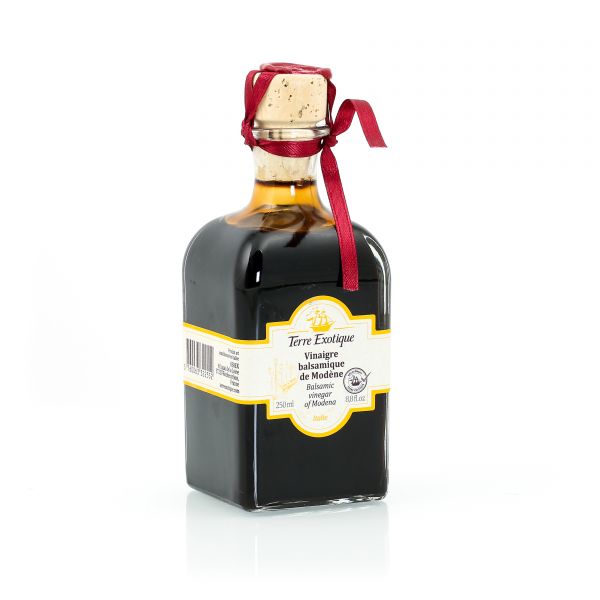Balsamic vinegar of Modena GI
31






Details
The rich syrupy texture and the slightly sweet taste of Terre Exotique’s Modena balsamic vinegar will charm all your Mediterranean style salads.
A drizzle of balsamic vinegar will enhance your salads, caramelized onions and even your vanilla ice-cream. The smooth rich texture and subtle aromas will delight all your dishes.How is Modena balsamic vinegar produced?
The expertise of the Emilia-Romagna region
Balsamic vinegar is made from “grape must”, the sweet juice of freshly pressed grapes which is boiled to a concentrate then aged for several years in barrels. This vinegar, with its very distinctive strong flavours and syrupy texture, is obtained via a traditional cooking technique: vincotto. The grape must is boiled and left to thicken in the cauldron. Then the vinegar is aged in wooden barrels for between 3 and 150 years depending on the particular grade of vinegar. The first stage of the maturing process is done in large oak barrels, in well-aired storehouses in the Emilia-Romagna region of Italy. The Angels’ Share evaporates leaving a concentrated concoction. Half of the contents of the barrel are then transferred to smaller casks, made from fine wood such as mulberry, chestnut, ash, which give the vinegar its woody aroma. The remaining half is mixed with more recently boiled grape must, and so the process continues year after year until this thick dark rich vinegar is obtained.Specific grape varieties, protected by PDO
This expertise which is specific to Emilia-Romagna, renowned because of the town of Modena, is protected by a PGI (Protected Geographical Indication) and a PDO (Protected Designation of Origin). This dictates the specific grape varieties that can be used to make balsamic vinegar. These are the grape varieties authorised for producing Modena vinegar: • Lambrusco, • Sangiovese, • Trebbiano, • Albana, • Ancellotta, • Fortana, • MontuniTerre Exotique’s balsamic vinegar: a dark treasure for everyday use
Terre Exotique’s balsamic vinegar complies with all stages of the traditional Italian expertise, except the stage when the vinegar is left to age further in smaller, fine wood casks, as this stage is reserved for the finest grade Modena vinegars. Thus offering excellent value for money, for a delectably divine treasure to use generously in all your daily dishes. Its strong rich flavour and thick smooth texture will enchant all your recipes!The powerful aromas of Modena balsamic vinegar
Modena balsamic vinegar is protected by PGI (Protected Geographical Indication). Its rich and smooth syrupy taste and its deep intense colour is why it’s known as the “Black Gold”of Modena. It releases powerful woody aromas, obtained by barrel ageing in casks of oak, mulberry or chestnut. This long maturing process sweetens its acidity. This balance of flavours is similar to “umami” used in Japanese cuisine.What dishes should I use Terre Exotique’s balsamic vinegar in?
You can use balsamic vinegar in both your sweet and savoury dishes
Use Modena vinegar to enhance your meat and fish dishes (tuna, fried squid, swordfish…). It is also a treat for your sweet recipes, drizzle over panna cotta, vanilla ice-cream or strawberry desserts.A harmonious bouquet of flavours for Italian dining
To start, serve up antipasti, pan-fried artichokes with parmesan shavings (carciofini sott'olio) drizzled with Modena balsamic vinegar. Slow oven roast tomatoes in a dish with balsamic vinegar, olive oil and garlic. You can then use them on a home-made pizza, with pasta or in a salad. For dessert, what better match than strawberries and balsamic vinegar! This typical Modena condiment is also delicious with Madagascar vanilla ice-cream.Balsamic vinegar known as the “Black Gold” of Emilia-Romagna
Managed by a consortium
Traditional Modena balsamic vinegar is a legendary product made for centuries. The vinegar producers have grouped together into a consortium Consorzio Produttori which is responsible for managing the Protected Designation of Origin. The consortium carries out regular checks all the way through the production chain.Balsamic ? Modena ? What’s the difference?
“Balsamic” is not a Protected Designation of Origin and any producer of sweet vinegar, using caramel or colouring, can call their vinegar balsamic, regardless of whether it’s from Modena or not. So check out the label carefully to see where your vinegar comes from when you buy it! Adding caramel thickens the vinegar and gives it a dark colour. To be sure you know what you’re getting, opt for "Modena", which means that the vinegar has been made in Modena, from boiled grape must using trebbiano grape variety and that it has been cask-aged. There are two different types of balsamic vinegar: - Modena balsamic vinegar which complies with all the conditions mentioned above, without any specific ageing conditions. - "Traditional" Modena balsamic vinegar which is aged for 12 or 25 years, in different barrels which are smaller in size over the years. It is rarer and far more expensive.Eat, Pray, Love…
The very mention of the Sixtine Chapel, the San Marco convent or the Fiat 500, makes you want to head off to Italy … but Italy also means parmigiano, lasagna, Modena vinegar and Parma ham! All these treasures come from the golden triangle of Italian gastronomy: Emilia-Romagna. Due to the strict conditions of the Protected Designation of Origin the age of the vinegar cannot be written on the bottles.More Information
| Price/kg | 102 |
|---|---|
| Allergen | Sulfites / Sulphites |
| Native country | Italie |
| Ingredients | cooked grape must, wine vinegar - SULPHITES. |
| Nutritional Info | VN Energie pour 100 g (energy for 100g) : 1410 kJ / 331 kcal VN Matière grasse (fat) : < 0.1 g Dont acide gras saturés (of which saturated fat) : < 0.1 g VN Glucides (carbohydrate) : 77 g Dont sucres (of which sugars) : 77 g VN Protéines (protein) : 1.2 g Vn Sel (salt) : 0 g |
| Contenance | 250ml |
| TRACES EVENTUELLES D'ALLERGÈNES | céleri, sésame, moutarde, fruits à coques. |
 Français
Français 

